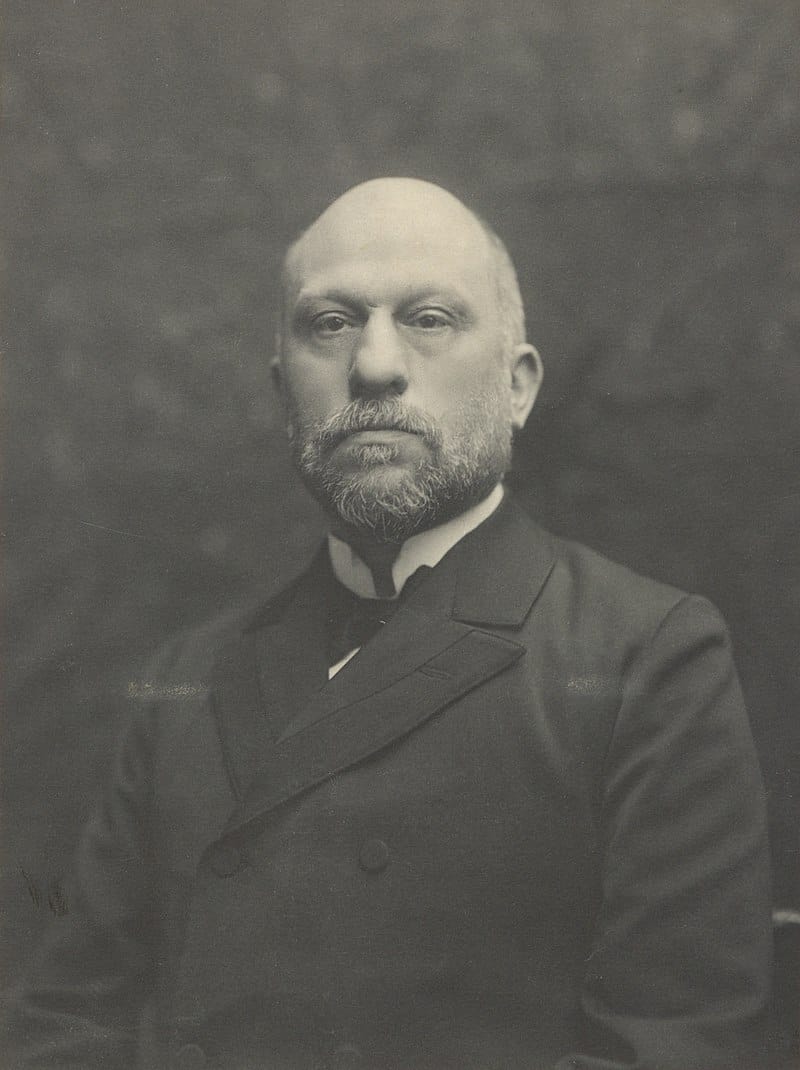
Angelo Mosso is captured here conducting an experiment with his pneumograph, an advancement in pneumatic transduction featuring two drums. This was a development from Marey’s earlier version of the pneumograph, which had only one drum equipped with a flexible guttapercha membrane. The photograph is provided courtesy of Marco R. Galloni.
Angelo Mosso (1846-1910) was an Italian physiologist renowned for his pioneering contributions to the fields of neurophysiology and psychology. His innovative research and inventions laid the groundwork for modern neuroscience, providing early insights into the workings of the human brain and its physiological responses to mental and emotional stimuli. This article delves into Mosso’s life, his key discoveries, and his enduring legacy in the scientific community.

Angelo Mosso, before 1910 – Turin Academy of Sciences
Table of Contents
ToggleBiography
- Birth: Angelo Mosso was born on May 30, 1846, in Turin, Italy.
- Education: In July 1870, he graduated with high honors (magna cum laude) from the University of Turin, earning his Doctor of Medicine degree.
- Early Career: Between 1870 and 1871, Mosso served as a battalion physician in various Italian cities, including Florence, Naples, Salerno, and Messina.
- Research Pursuits: From 1871 to 1874, he conducted research under Maurizio Schiff in Florence, Italy. It was here that Giulio Ceradini introduced Mosso to the graphical method, a pivotal moment in his scientific career.
- Further Studies: Between 1874 and 1875, Mosso worked with Carl Ludwig and studied the graphical method under Leopold Kronecker in Leipzig, Germany.
- Paris and Turin: In 1875, Mosso traveled to Paris to collaborate with notable scientists Claude Bernard and Étienne-Jules Marey. Upon his return to Turin, he was appointed Professor of Pharmacology at the University of Turin.
- Chair of Physiology: Mosso held the prestigious position of Chair of Physiology at the University of Turin from 1879 to 1904.
- Awards: In 1879, the Accademia dei Lincei honored him with the Royal Prize for his significant contributions to understanding blood circulation in the brain. In December 1881, he was made a National Fellow of the Accademia dei Lincei.
- Editorial Work: In 1882, Mosso, along with zoologist Carlo Emery, established the scientific journal Les Archives Italiennes de Biologie.
- International Recognition: In 1901, he presided over the 5th International Congress of Physiologists in Turin, showcasing his international stature in the field.
- Political Career: By 1904, Mosso was recognized for his contributions to science and Italy, becoming a Senator of the Kingdom of Italy.
- Olympic Games: In 1905, he was invited to speak at the Olympic Games in Rome, Italy, highlighting his influence beyond the scientific community.
- Death: Angelo Mosso passed away on November 24, 1910, with his death attributed to complications from diabetes.
Angelo Mosso: A Trailblazer in Neuroimaging and Muscle Physiology
Angelo Mosso’s contributions to medical science in the late 19th and early 20th centuries have left an indelible mark on the fields of neurophysiology and muscle physiology. His pioneering work laid the foundations for modern neuroimaging techniques and significantly advanced our understanding of muscle fatigue.
The Mosso Method and Mosso Balance
In the 1880s, Mosso made significant strides in measuring cerebral blood flow and its relation to mental activity. Inspired by the graphical methods of Étienne-Jules Marey, Mosso developed a special plethysmograph to measure the pulsations of the human cortex in patients with skull defects. This led to the creation of the Mosso Method, where he correlated increased mental activity with heightened blood flow to the brain. His findings were meticulously documented in “Sulla circolazione del sangue nel cervello dell’uomo” (On the Circulation of Blood in the Human Brain).
To extend his research to individuals without skull defects, Mosso invented the “human circulation balance” or Mosso’s balance. This device, a wooden table that could detect minute changes in weight distribution caused by cerebral blood flow, represented a significant leap in non-invasive brain research. Mosso’s balance is considered a precursor to modern neuroimaging techniques such as fMRI and PET scans, highlighting his role as a pioneer in the field.
Bozzolo Sign and Muscular Fatigue
Beyond neuroimaging, Mosso contributed to other medical domains, including the discovery of the Bozzolo sign in 1887. This sign, visible pulsation of the arteries within the nasal mucosa, was initially linked to thoracic aortic aneurysm and later to aortic regurgitation. Mosso’s work in this area built upon the studies of Giulio Ceradini, showcasing the collaborative spirit of scientific discovery during that era.
Mosso’s most influential work on muscle physiology came in 1891 with the publication of “La Fatica” (Fatigue), a comprehensive study on muscle fatigue. Utilizing an ergograph, a device he modified for measuring muscle contractions, Mosso explored fatigue under various conditions. His research distinguished between mental and muscular influences on fatigue, demonstrated the benefits of exercise on muscular strength and endurance, and formulated laws regarding exhaustion. “La Fatica” transcended its scientific roots, influencing a wide range of professionals from doctors to sociologists and even revolutionaries, by intertwining scientific findings with cultural and sociopolitical themes.
Mosso’s innovative approaches and dedication to understanding the human body’s complex mechanisms earned him the Royal Prize from the Accademia dei Lincei in 1879. His work, particularly in developing the first-ever neuroimaging technique and his comprehensive studies on muscle fatigue, has been celebrated for over a century, with his contributions to muscle fatigue commemorated during the 2005 International Congress of Physiological Sciences.
Angelo Mosso’s legacy is that of a visionary who bridged the gap between physiological phenomena and graphical methods, paving the way for future generations to explore the mysteries of the human brain and body with greater precision and understanding. His pioneering spirit continues to inspire researchers and clinicians in the ongoing quest to unravel the complexities of human physiology.
Early Life and Education
Born in Turin, Italy, Mosso demonstrated an early interest in the natural sciences. He pursued his education at the University of Turin, where he graduated with a degree in medicine in 1870. Under the mentorship of esteemed physiologist Jacob Moleschott, Mosso’s passion for research, particularly in human physiology, was ignited.
Pioneering Work in Neuroscience
Mosso’s work was characterized by his innovative approach to studying the physiological aspects of the brain. Among his most notable contributions was the development of the plethysmograph, an instrument designed to measure changes in volume within an organ or whole body, often used to detect changes in blood flow to the brain in response to cognitive and emotional stimuli.
The Human Circulation Balance
One of Mosso’s groundbreaking inventions was the “human circulation balance,” which he used to demonstrate the redistribution of blood flow between the brain and other parts of the body during mental activity. This apparatus allowed Mosso to quantitatively measure the increase in blood flow to the brain as subjects engaged in intellectual tasks, providing early evidence of the brain’s activity levels in relation to mental exertion.
Studies on Fatigue
Mosso also conducted extensive research on the effects of physical and mental fatigue on human performance. His work in this area was revolutionary, showing that fatigue was not solely a muscular phenomenon but also had significant psychological components. This led to a deeper understanding of the importance of rest and recovery in both physical and cognitive performance.
The Fear Reflex
Another significant area of Mosso’s research was the study of the physiological responses to fear and anxiety. Through experiments, he was able to demonstrate how emotions could trigger physical reactions, such as changes in blood pressure, heart rate, and muscle tension. This research contributed to the early foundations of what would later become psychophysiology.
Legacy and Impact
Angelo Mosso’s contributions to neuroscience and physiology were far-reaching. His methods and discoveries opened new pathways for understanding the complex interactions between the mind and body. Mosso’s work on cerebral blood flow and the physiological correlates of mental activities paved the way for future neuroimaging techniques, such as fMRI and PET scans, which are now fundamental tools in neuroscience research.
Moreover, his insights into the nature of fatigue have influenced various fields, from sports science to occupational health, highlighting the multidimensional aspects of human performance and well-being.
Angelo Mosso’s pioneering spirit and innovative research have left an indelible mark on the field of neuroscience. By exploring the physiological underpinnings of mental and emotional processes, Mosso helped bridge the gap between the physical and psychological realms. His legacy continues to inspire current and future generations of scientists, as the quest to unravel the mysteries of the human brain and its functions moves forward.
Contribution to Polygraph Development
Among Angelo Mosso’s lesser-known yet significant contributions is his influence on the development of the polygraph, commonly known as the lie detector. His early work on the fear reflex and the physiological manifestations of emotions laid foundational principles that would later be integral to the concept of lie detection. Mosso’s studies on how fear and stress affect bodily functions, such as heart rate, blood pressure, and respiration, provided crucial insights into the body’s involuntary responses to psychological stimuli.
This work indirectly informed the development of the polygraph by highlighting the link between physiological changes and psychological states. The polygraph relies on monitoring several physical responses, including those Mosso investigated, to infer deception based on the premise that lying induces a unique set of physiological responses due to increased cognitive load and anxiety.
While Mosso himself did not invent the polygraph, his research contributed to the understanding of the autonomic nervous system’s role in emotional and psychological experiences. This understanding is fundamental to the polygraph’s mechanism, which assesses the body’s automatic, uncontrollable reactions to determine truthfulness. Thus, Angelo Mosso’s pioneering work in the physiology of emotions and stress responses can be seen as an early cornerstone upon which the principles of polygraphy were built.

